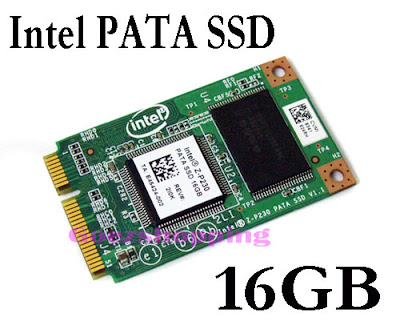 Intel® X25-M and X18-M Mainstream SATA Solid-State DrivesOverviewHigh-Performance Storage for Notebook and Desktop PCs
Intel® X25-M and X18-M Mainstream SATA Solid-State DrivesOverviewHigh-Performance Storage for Notebook and Desktop PCsThe Intel® X25-M and X18-M Mainstream SATA Solid-State Drive (SSD) brings a new level of performance and reliability to laptop and desktop PC storage.
Wait less. Do more.Why wait for a traditional hard disk drive to spin up? Unlike traditional hard disk drives, Intel solid-state drives have no moving parts, resulting in a quiet, cool, highly rugged storage solution that also offers faster system responsiveness. And for laptop PCs, the lower power needs of Intel SSDs translate to longer battery life and lighter notebooks. Higher performance with more durability means you can be truly mobile with confidence.
Better by designDrawing from decades of memory engineering experience, Intel Mainstream SATA Solid-State Drives are designed to deliver
outstanding performance, featuring the latest-generation native SATA interface with an advanced architecture employing 10 parallel NAND flash channels equipped with multi-level cell NAND flash memory. With powerful Native Command Queuing to enable up to 32 concurrent operations, Intel Mainstream SATA SSDs deliver higher input/output per second and throughput performance than other SSDs on the market today - and drastically outperform traditional hard disk drives. These drives also feature low write amplification and a unique wear-leveling design for higher reliability, meaning Intel drives not only perform better - they last longer.
Two options. No worries.Intel® Mainstream Solid-State Drives are available in either 2.5in (Intel® X25-M Mainstream SATA Solid-State Drive) or 1.8in (Intel® X18-M Mainstream SATA Solid-State Drive) standard hard drive form factors. And all Intel Mainstream SSDs are tested and validated on the latest Intel-based mobile and desktop platforms for your peace of mind.
 Product informationDownload product briefView animation: "Intel® Solid-State Drives: Better by Design"View customer testimonial: Lenovo, Hewlett-Packard and Sun MicrosystemsTechnical specificationsModel Name
Product informationDownload product briefView animation: "Intel® Solid-State Drives: Better by Design"View customer testimonial: Lenovo, Hewlett-Packard and Sun MicrosystemsTechnical specificationsModel NameIntel® X18-M Mainstream SATA Solid-State Drive
Intel® X25-M Mainstream SATA Solid-State Drive
Capacity80GB and 160GB
NAND Flash ComponentsIntel® Multi-Level Cell (MLC) NAND Flash Memory10 Channel Parallel Architecture with 50nm MLC ONFI 1.0 NAND
BandwidthUp to 250MB/s Read SpeedsUp to 70MB/s Write Speeds
Read Latency85 microseconds
InterfaceSATA 1.5 Gb/s and 3.0 Gb/s
Form factorX18-M: Industry Standard Hard Drive Form Factor80GB drive: 1.8in by 5.0mm
160GB drive: 1.8in by 8.0mm
X25-M: Industry Standard Hard Drive Form Factor80GB drive: 2.5in by 7mm and 2.5in by 9.5mm options
160GB drive: 2.5in by 7mm and 2.5in by 9.5mm options
X25-M: 2.5in Industry Standard Hard Drive Form FactorCompatibilitySATA Revision 2.6 Compliant. Compatible with SATA 3.0 Gb/s with Native Command Queuing and SATA 1.5 Gb/s interface rates
Life expectancy1.2 million hours Mean Time Before Failure (MTBF)
Power consumptionActive: 150mW Typical (PC workload¹)Idle (DIPM): 0.06W Typical
Operating shock1,000G / 0.5ms
Operating temperature0°C to +70°C
RoHS ComplianceMeets the requirements of EU RoHS Compliance Directives
Product health monitoringSelf-Monitoring, Analysis and Reporting Technology (S.M.A.R.T.) commands plus additional SSD monitoring
 Return To Castle Intel: 16 Years Of Motherboard History
Return To Castle Intel: 16 Years Of Motherboard History





















